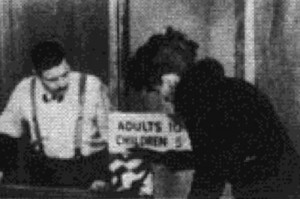
"This takes us back to the Bijou days, the serial pictures, the villain with the mustache, and the slapstick comedy. It is a picture of several pictures, including lantern slides, and a soloist who sings to the accompaniment of a piano and lantern slides for the visual. A family goes to the 10¢ movie in the days which some of us like to look back to and reminisce as the good old days, before the talking pictures. This will be blownup to 16mm and included in the Package" PSA Journal, Oct. 1962, 34.
"Night Call, made by Elizabeth Sansom, ACL, and Kenneth V. Bloomer, ACL, is noteworthy for its attention to exact detail in the portrayal of an event in the daily (and nightly) routine in the lives of two physicians who receive a "hurry call" to perform an appendicitis operation. Miss Sansom, in the course of the story, films an operation sequence that seems letter perfect, both from the point of view of the operation itself and of the lighting, closeup and photographic technique employed." Movie Makers, Dec. 1933, 523.
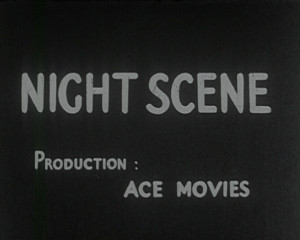
"London's West End by night. Street life and theatrical exteriors. Three couples (Kae Lomas and Ben Carleton, Phyllis Robertson and Keith Hodder, Frieda Hale and Geoffrey Collyer) meet and have varied reactions. For the first couple it is idyllic. The second couple experience friction. The third couple spend the evening apart! Features neon-lit facades of Alhambra, Capitol and His Majesty's Theatre and everyone smoking" (EAFA Database).
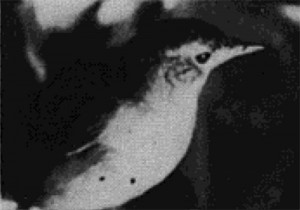
"Tullio Pellegrini has filmed a delightful little story in which boy meets girl and together they watch the nesting, hatching and feeding of the baby nightingales. There are the tender moments of meeting and getting acquainted; the disappointment when one cannot keep the appointed date; and the return of two hearts to their earlier meeting place to the welcome and song of the newly grown nightingales" PSA Journal, Nov. 1958, 46.
"only our second film – but good enough to be picked from among the whole of the entry in The Era Contest of 1932 to represent Great Britain in the International Contest, in which it took second prize… The film, which was but 180 feet in length, was an attempt to portray pictorially the workings of an unhinged mind; a subject, you will agree, that no professional could possibly exploit. The production was, maybe, a trifle crude – I would be the last to deny it – but at least the theme was original" (Mellor 1933: 102).
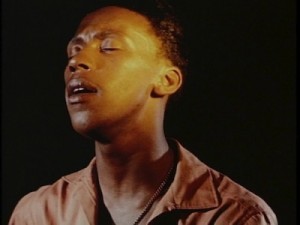
"Nightsong is a dramatic story of a colored night club singer, Willie Wright, trying to make the big time and, most of all "to get people to like me." One evening while singing, his eyes rest on the face of a beautiful young white girl and his infatuation with her becomes unmistakable as the story unfolds. The film is 99% visual with a sound track that places great emphasis on the various moods of the young singer" PSA Journal, Sept. 1965, 50.
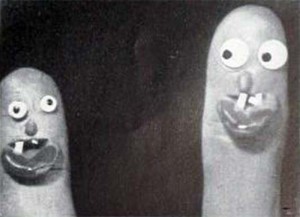
"A perfectly delightful holiday in personal filming, replete with humor, and imagination, is the comedy, Nite Life, produced by J. Kinney Moore, entirely in Kodachrome and, what is more, almost entirely in interior Kodachrome, by artificial light. Mr. Moore, in his work, refutes the contention, sometimes heard, that the amateur should be wary of film comedy. And, beside negotiating this pinnacle successfully, the producer has added an outstanding technical handling of Kodachrome, as well as a highly diverting and intelligent use of the various camera illusions it is possible to produce with the aid of modern 16mm. equipment. The obvious zest and pleasure with which the actor producer entered into the creation of this film add immeasurably to its value as a genuine document of personal filming achievement. Examples of carefully planned and executed trick photography follow one another in such rapid succession in the film that the spectator is left time only to gasp. However, these tricks are not executed simply for their own sake, but strictly in accordance with the furtherance of the plot. It must be said that, in the second part of the film, the author does yield slightly to the temptation of attenuating the action somewhat in order to spin out his bag of tricks. But the film as a whole is so delightful that any audience could easily forgive this small shortcoming." Movie Makers, Dec. 1936, 542.
"About two people who read an article on cancer being caused by smoking, and who decides to give it up. Neither does, but their evasions make many humorous situations. They finally catch each other sniping butts and call the whole thing off." PSA Journal, Nov. 1956, 45.
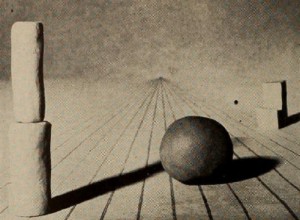
"Relegated to Honorable Mention only because it has been used commercially, No Credit, a brief and amusing abstract film, would under normal conditions have attained a much higher rating. The picture, produced by Leonard W. Tregillus, is a study in forms and movement accompanied by music. Much of it is single frame work that must have required infinite pains. This sounds alarmingly modern and incomprehensible; but since the film does not have to use words and depends for its effect solely on the cameraman's sense of timing, mood and music, the end result is altogether entertaining. Most abstract films seem to illustrate a theory or argue a point. No Credit stands on its own merits of creative form and movement, integrated with a stimulating musical score." Movie Makers, Dec. 1948, 494.
"Begins with a close-up intro of the Davis's in a small boat. One of the girls falls overboard and is saved. A woman drops her jewels overboard. Family disembarks. Finds a clue on a piece of paper. The Family sets out in boat with shovels, saws, axes, etc. Quarrel with another family. Find a deed." oldfilm.org
Total Pages: 203